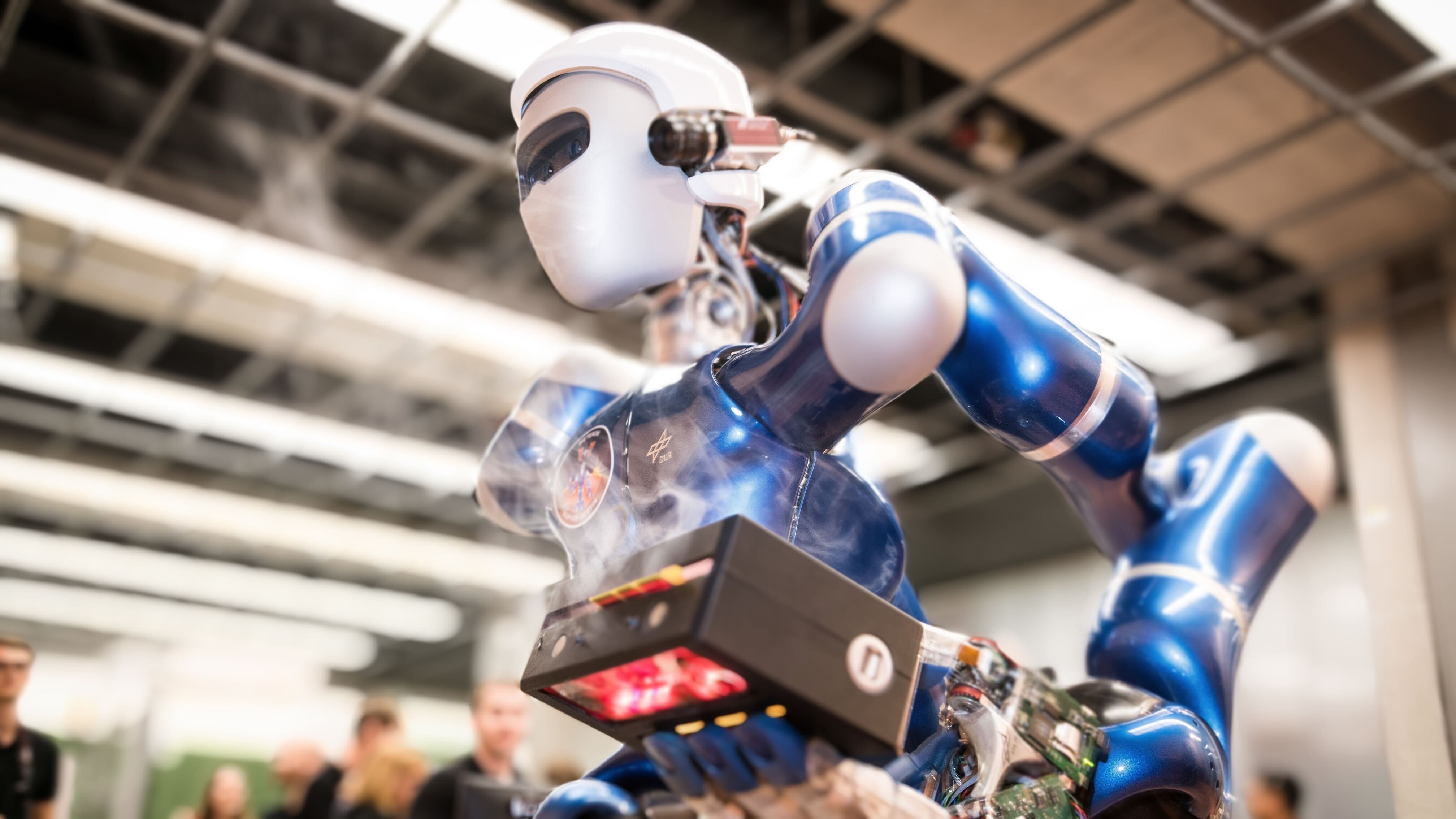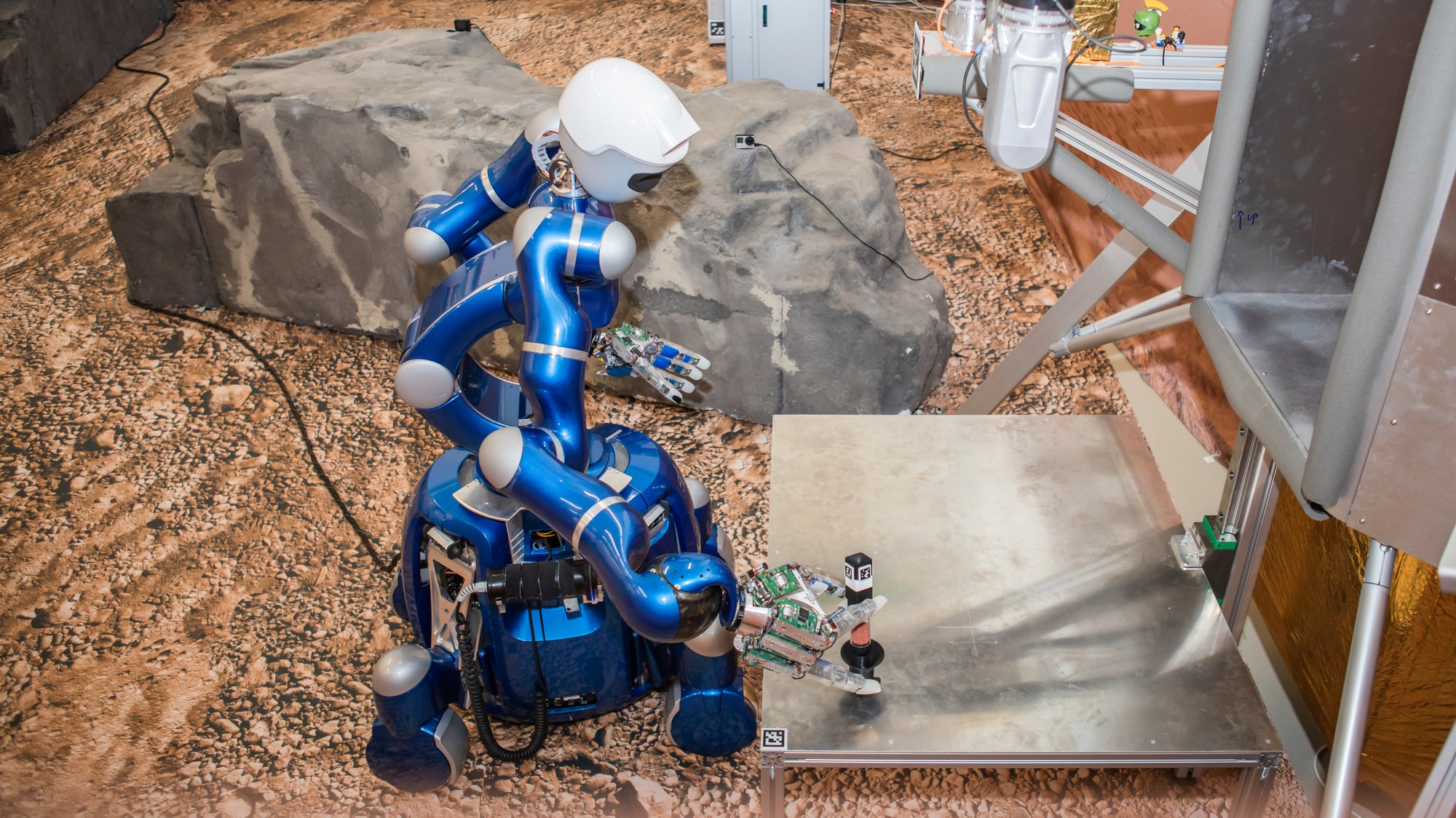Meet Rollin' Justin, the human-like robot that astronauts control from space
The robot just explored a Mars-like world, with help from an International Space Station astronaut.
Denmark astronaut Andreas Mogensen loves space robots.
The International Space Station (ISS) astronaut did a rover experiment from space in 2015, and can't wait to keep going. Mogensen will next control Rollin' Justin, a humanoid hit among ISS astronauts, after his launch that takes place no earlier than Aug. 17.
"It's about planning and executing surface operations using a slew of different robotics," Mogensen told Space.com in a Zoom interview Tuesday (July 25).
SpaceX's forthcoming Crew-7 mission for NASA includes Mogensen, NASA astronaut Jasmin Moghbeli, Japan Aerospace Exploration Agency astronaut Satoshi Furukawa, and Russian cosmonaut Konstantin Borisov of Roscosmos. The quartet will launch from NASA's Kennedy Space Center at 6:56 a.m. EDT (1056 GMT). You can watch the events live at Space.com, via NASA Television.
Related: SpaceX's Crew-7 astronaut launch delayed to Aug. 17
The six-foot (2-meter) Rollin' Justin is one of four robot concepts for exploring the moon or Mars that Mogensen will investigate sometime during his six-month mission, the European Space Agency astronaut (ESA) explained.
"It's one of the experiments that I'm really looking forward to," Mogensen said, and he added he's been watching closely as other astronauts get their turn. This week, for example, the German space agency (DLR) announced that NASA astronaut Frank Rubio recently rolled the 440-pound (220-kg) Justin around from the ISS.
Breaking space news, the latest updates on rocket launches, skywatching events and more!
With Rubio at the controls in the ESA Columbus module, Justin and three other robots explored a Mars-like landscape in Germany. Their sandbox at the German Space Operations Center in Oberpfaffenhofen let everyone practice how to set up an astronaut base on the Red Planet with robots.
"At the push of a button, (Rubio) could have a robot perform a task completely autonomously," DLR said in a statement. "But the astronaut could also take over the robot as an avatar and carry out individual steps as if with his own hand."
Rollin' Justin was unveiled to the public in 2008 and his first space partnership was in 2017, with Italian astronaut Paolo Nespoli. Justin has had plenty of planet practice since then. The robot simulated repairs on Mars in 2018 with Germany's Alexander Gerst, for example.
Justin and the robot's siblings have shown off their skills many times on video: Maintenance tasks like tidying and wiping, or classifying materials by touch. In the far future, these tests could help future humanoids take some easy tasks off astronaut hands to allow crews to focus on science.
Features of Justin include "compliant, lightweight arms and four-finger hands," according to the robot's DLR specifications. There are many other humanoid robots out there, like NASA's Robonaut 2 that operated for years on the ISS before flying home for repairs, for example. Less human-looking, but no less helpful, are arm-shaped robots like Canada's Canadarm2 and Japan's Kibo on the ISS.
Mogensen's forthcoming experiment follows on from more than 10 years of space-controlled robots with ESA and DLR, starting with NASA astronaut Sunita Williams driving a Lego rover from space in 2012. Mogensen told Space.com his own 2015 rover drive, using a more space-like version, was one of the more "fascinating" experiments he performed during his 10-day science mission.
Related: European astronaut uses 'the Force' to control rover from space
Mogensen praised the force feedback on his controller that let him "feel" his way while moving a ground rover around to do common tasks. "I could feel the resistance, for example, when I was inserting a nail or screw into a hole," he recalled.
The human-robot partnership was not only about putting small pegs into round holes, but it demonstrated "millimeter precision" similar to repairing electric connections, ESA stated of the experiment in which Mogensen participated.
NASA and its Artemis program partners are planning to bring humans to the moon's surface as soon as 2025 or 2026, after the Artemis 2 moon mission with four astronauts does a lunar-circling venture in November 2024 or so. The partners are also working on a moon space station known as Gateway.
It's possible (although not confirmed) that astronauts on Gateway may control rovers and robots on the moon one day. But even if not, a lot of robotics are going to the surface. NASA's Commercial Lunar Payload Services (CLPS) program is just one of many ventures that space agencies and private companies are working on to send moon rovers, landers and other tools.

Elizabeth Howell (she/her), Ph.D., was a staff writer in the spaceflight channel between 2022 and 2024 specializing in Canadian space news. She was contributing writer for Space.com for 10 years from 2012 to 2024. Elizabeth's reporting includes multiple exclusives with the White House, leading world coverage about a lost-and-found space tomato on the International Space Station, witnessing five human spaceflight launches on two continents, flying parabolic, working inside a spacesuit, and participating in a simulated Mars mission. Her latest book, "Why Am I Taller?" (ECW Press, 2022) is co-written with astronaut Dave Williams.


